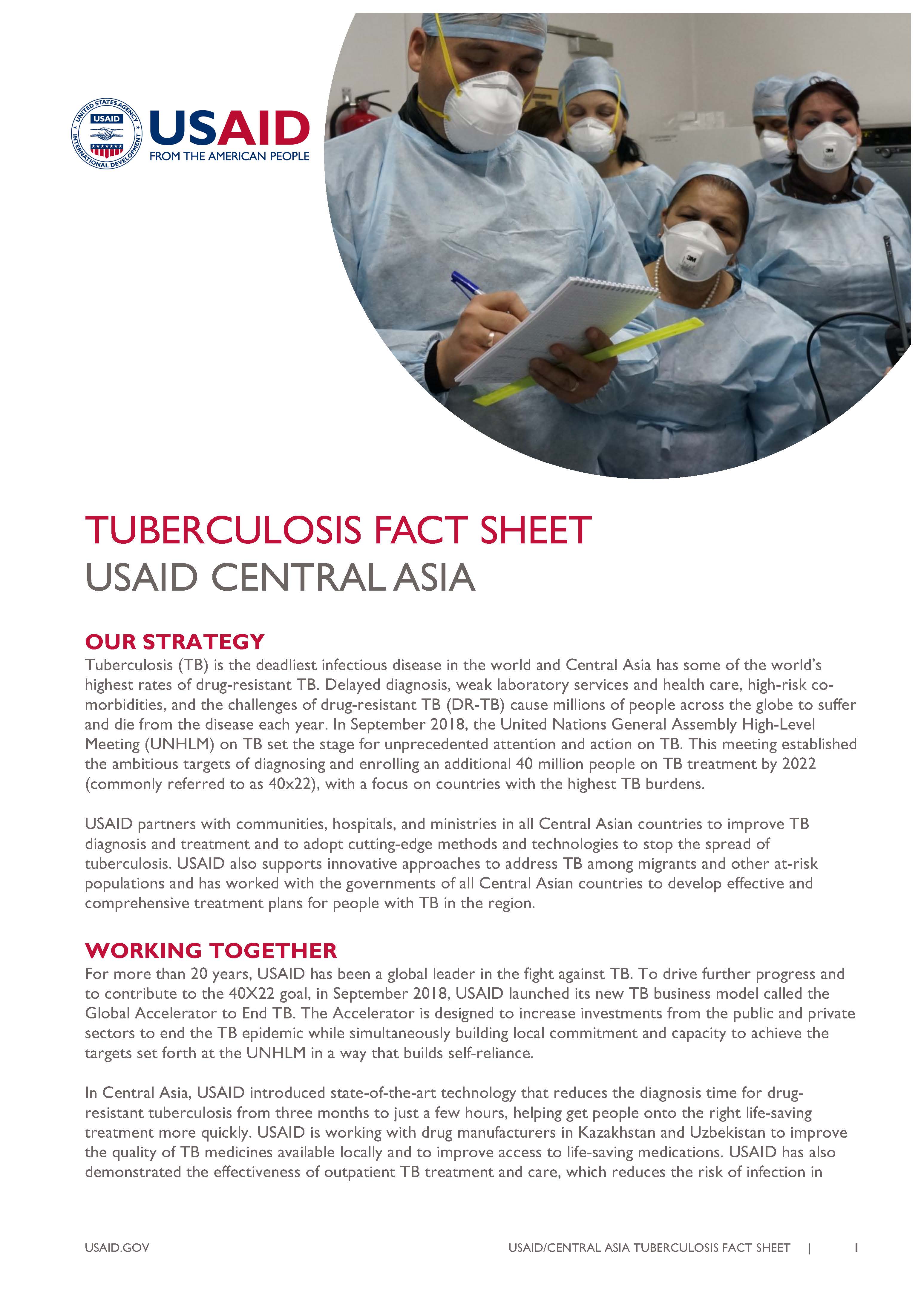Speeches Shim
Tuberculosis Fact Sheet ![]() (pdf - 367k)
(pdf - 367k)
Our Strategy
Tuberculosis (TB) is the deadliest infectious disease in the world and Central Asia has some of the world’s highest rates of drug-resistant TB. Delayed diagnosis, weak laboratory services and health care, high-risk co-morbidities, and the challenges of drug-resistant TB (DR-TB) cause millions of people across the globe to suffer and die from the disease each year. In September 2018, the United Nations General Assembly High-Level Meeting (UNHLM) on TB set the stage for unprecedented attention and action on TB. This meeting established the ambitious targets of diagnosing and enrolling an additional 40 million people on TB treatment by 2022 (commonly referred to as 40x22), with a focus on countries with the highest TB burdens.
USAID partners with communities, hospitals, and ministries in all Central Asian countries to improve TB diagnosis and treatment and to adopt cutting-edge methods and technologies to stop the spread of tuberculosis. USAID also supports innovative approaches to address TB among migrants and other at-risk populations and has worked with the governments of all Central Asian countries to develop effective and comprehensive treatment plans for people with TB in the region.
Working Together
For more than 20 years, USAID has been a global leader in the fight against TB. To drive further progress and to contribute to the 40X22 goal, in September 2018, USAID launched its new TB business model called the Global Accelerator to End TB. The Accelerator is designed to increase investments from the public and private sectors to end the TB epidemic while simultaneously building local commitment and capacity to achieve the targets set forth at the UNHLM in a way that builds self-reliance.
In Central Asia, USAID introduced state-of-the-art technology that reduces the diagnosis time for drug-resistant tuberculosis from three months to just a few hours, helping get people onto the right life-saving treatment more quickly. USAID is working with drug manufacturers in Kazakhstan and Uzbekistan to improve the quality of TB medicines available locally and to improve access to life-saving medications. USAID has also demonstrated the effectiveness of outpatient TB treatment and care, which reduces the risk of infection in hospitals, lowers overall treatment costs, and removes the fear of extended periods of quarantine. Through the Accelerator, USAID continues to promote prevention strategies, improve patient-centric care, strengthen service delivery, and provide new diagnostics and drugs in the fight against TB. To address the specific challenges of multidrug-resistant tuberculosis (MDR-TB) patients, USAID is expanding the availability of new MDR-TB drugs and regimens that save lives.
What We Do
Treatment and Care
USAID works with health care providers from the village doctor to the highest levels of government to ensure that TB patients in Central Asia receive treatment and care in line with World Health Organization (WHO) recommendations.
Strengthen Institutional Capacity
USAID has worked with TB hospitals and clinics to improve their laboratory equipment, diagnostic and treatment methods and infection control; with governments to put reforms into law; and with medical universities to ensure that the progress made on fighting TB is continued by the next generation of doctors and nurses.
Improve Access To Treatment
USAID identifies barriers to treatment, including stigma and misinformation, as well as the social and economic costs of TB. USAID works with community leaders to raise awareness of TB and to mobilize communities to provide support for patients and their families affected by the disease to ensure adherence to and successful completion of treatment.
Projects
- The Eliminating Tuberculosis in Central Asia project supports the measurable and sustainable improvements in the quality and availability of DR-TB services by building the capacity of Central Asian institutions in TB leadership, management, financing, and information systems. The project improves TB service delivery by ensuring skilled and motivated providers in laboratories and health facilities and accessible drugs, supplies, and services. The project works with communities to reduce TB stigma and provide comprehensive support services to TB patients to ensure successful completion of treatment.
- The Improved Prevention, Detection, and Treatment of Drug-Resistant Tuberculosis project in Central Asia focuses on high-level policy engagement with National Tuberculosis Programs (NTPs) in Central Asia, and provides technical assistance at the national level to support introduction and scale up of the new approaches for DR-TB prevention, detection, treatment and care. The project supports the NTPs to reach the targets set forth in the UNHLM on TB, the United States Government’s Global TB Strategy 2015-2019, and the Global WHO End TB Strategy.
- The Promoting the Quality of Medicines Plus project works to improve medical product quality and the application of international quality assurance standards across the pharmaceutical system. Specifically, the program provides technical assistance to TB drug manufacturers in Kazakhstan and Uzbekistan to develop the capacity of local pharmaceutical professionals to produce high quality anti-TB medicines to ensure compliance with international standards of Good Manufacturing Practices (GMP). The project also helps improve the quality and standards of the regional drug laboratories in Kazakhstan so that they can receive International Organization of Standardization (ISO) accreditation and are thus able to assure the quality of drugs being used in the region.
- The Sustaining Technical and Analytic Resources project embeds senior-level TB technical advisors in National TB Programs within Ministries of Health to support more sustainable and focused TB programming. As the countries move towards alignment with the WHO’s Global End TB Strategy, a shift away from hospitalization to outpatient treatment is expected. The advisors support the costing of TB services and introduction of new TB payment methods to support implementation of more outpatient treatment, resulting in more efficient and safer TB care, provide technical assistance to improve the quality of anti-TB medicines and building the capacity of local medicine manufacturers to comply with international Good Manufacturing Practices.


Comment
Make a general inquiry or suggest an improvement.